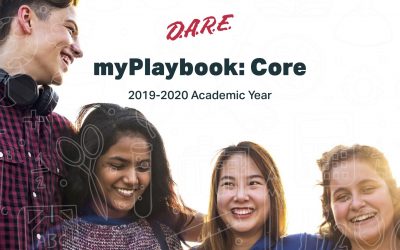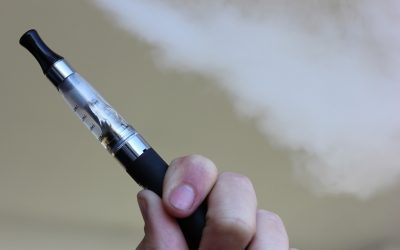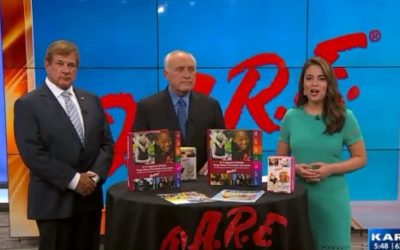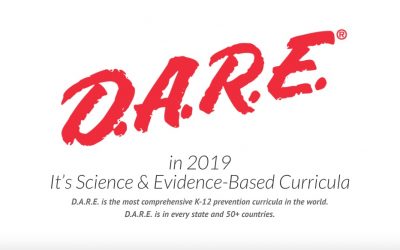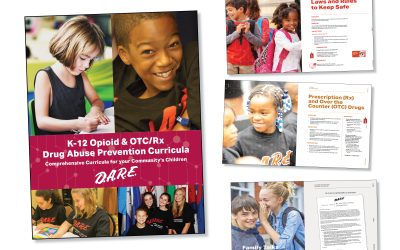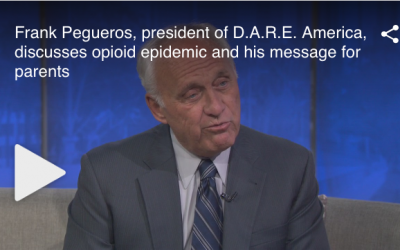
But if you attended elementary school in the 1980s and 1990s, when the nationwide program was in its infancy, a lot has changed. Your children today are taking a different D.A.R.E. While the much-praised collaboration between the police force and public schools continues unabated, its approach – and much of what School Resource Officer Brandon Heide brings to the classroom this fall – has evolved dramatically.
Gone are the hour-long lectures on illegal drugs meant to warn youngsters away from trying them. Instead, says Heide, the 19 classes he teaches each week at Horizon Middle School focus far more on broader challenges facing preteens. Among them: bullying, peer pressure and tools for good decision-making in every area of their lives. Alcohol and tobacco resistance strategies are included, too.
School Resource Officer Jordan Werk, who was in change of D.A.R.E. education during the 2021-22 school year, says that she went through the old curriculum when growing up in central Minnesota. “It was all about drugs – what they are, what they do and why they can hurt you.” The officer did most of the talking.
Today that practice has been turned on its head. The new D.A.R.E. curriculum, introduced in 2009 and adopted nationally by 2013, emphasizes two-way communication, with the officer posing scenarios and the students chiming in about their own lives and the challenges they have faced or witnessed. “A lot of it is give and take,” Heide reports.
“What I do is fill in the blanks. They see older kids smoking – at least one or two in every class bring up vaping. They’re very aware. They ask, ‘So what do I do? What if it’s offered to me?’ So we talk about resistance strategies they can use in different situations.”
The change in focus from all-drugs to decision-making was driven by research on the effectiveness of D.A.R.E. training. Begun in Los Angeles in 1983, research showed the widely applauded substance-avoidance program didn’t work as intended. According to reporting in Scientific American, “Despite being the nation’s most popular substance-abuse prevention program, D.A.R.E. did not make you less likely to become a drug addict or even to refuse that first beer from your friends.” According to an evaluation in 1994, it showed only a small short-term reduction in tobacco use, and none at all for alcohol and marijuana.
Instead, the nonprofit program sponsor, D.A.R.E. America, turned to an approach that does seem to send boys and girls down a healthier path: “The new course, called ‘keepin’ it REAL,’ differs in both form and content from the former D.A.R.E. — replacing long, drug-fact laden lectures with interactive lessons that present stories meant to help kids make smart decisions.”
Even the meaning of the program’s name was adjusted. Now, says Werk, the D in D.A.R.E. stands for “defining the problem.” A is “assess your options.” R is “respond” – making your choice. The final E is for “evaluation,” when you look back afterwards on how well the choice you made worked out and its consequences.
And this decision-making approach, designed by behavioral scientists rather than cops, does work. Instructors speak only for about eight minutes during each lesson, partly so students can spend more time practicing tough decisions in activities with their friends. “If we teach good decision-making skills, it should transfer from one high-risk behavior to the next,” Heide says.
Heide is in his third year with the Moorhead police; Werk has been an officer for six and one-half years. Both were excited about the opportunity to work in the schools.
They prepared for their role in the classrooms at an intense two-week D.A.R.E. school. “They teach you to be a teacher, rather than a police officer,” Heide explains. “Most cops have never been in front of a classroom of kids.” Asked about what surprised him, he says, “The most shocking thing? How tiring it is!”
Both officers say the best part of their assignment as school resource officers is the kids. “I like to hang out with them. A big part of our job is building good relationships … letting them know that talking to a police officer isn’t scary.” Much of those trusting relationships is based on informal interaction. “I’ve played basketball after lunch and tossed and catch a football while they’re waiting for the bus,” he says.
Many children, he says, believe cops to be stern, intimidating people to be afraid of. Tearing down that wall is one of their central goals. “If we can build trusting relationships when they’re in fifth grade and even years after, they’ll be more willing to talk to us,” Werk says.
“That’s the best part of the job: I get to hang out with kids on their good days. In law enforcement, we usually see people on the worst days of their lives.
And though Heide is only in his first month of D.A.R.E. classes at Horizon West, he has already seen perks from that growing bond.
“When I was driving a [police] car in the Greater Moorhead Days parade, kids yelled, ‘Hey, that’s my D.A.R.E. officer’ and waved,” he reports. “They made me feel a little bit like a celebrity.”
Prevention 101: The Science Behind Healthy Decision Making for Students
The D.A.R.E. America – National School Board Association webinar conducted by Richard Clayton, PhD and David L. Wyrick, PhD on August 13, 2019 is now online to view. The webinar will help the listener understand the evidence and theoretical base underlying Prevention Science, identifying the D.A.R.E. curricula as a model program. The D.A.R.E. curricula focuses on providing cutting edge instruction that helps prevent drug use by developing basic, core Socio-Emotional skills needed for safe and responsible choices…
D.A.R.E. Launches New High School Curriculum
myPlaybook: Core is a four-lesson curriculum designed for delivery to High School Students, ideally in 9th or 10th grade. The lesson content is aligned with D.A.R.E. Elementary and Middle school program concepts, continuing the focus on understanding risk behavior…
D.A.R.E. Partners with American Foundation for Suicide Prevention to Launch “More than Sad”…Teen Mental Health Enhancement Lesson
More Than Sad is a 45 minute enhancement lesson designed for delivery by D.A.R.E. Officers to High School students, ideally in 9th or 10th grade. D.A.R.E. collaborated with the American Foundation for Suicide Prevention (AFSP) to adapt this lesson for delivery by…
D.A.R.E. Responds to Vaping Crisis with New Enhancement Lesson
Vaping nicotine nearly doubled among high school seniors from 11 percent in 2017 to 20.9 percent in 2018. More than 1 in 10 eighth graders (10.9 percent) say they vaped nicotine in the past year, and use is up significantly in virtually all vaping measures among…
3 Big Prevention Ideas to Keep Young People Safe and Healthy
Navigating teen life while confronted with current issues like vaping, teen suicide, social media bullying, and illicit drugs, including today’s opioid epidemic, mean young people today must make critical choices at an early age. The hopeful news is communities that...
D.A.R.E. Implementing Opioid Education in Schools
D.A.R.E is implementing opioid education programs in schools to combat opioid addiction at a younger age. The enhancement lessons are being taught at each grade level…
D.A.R.E. in 2019 – It’s Science & Evidence-Based Curricula
Read an article about D.A.R.E. by Richard Clayton, Ph.D., former Chair of Health Education and Health Promotion in the College of Public Health at the University of Kentucky. For more than 20 years, he was the director of the federally funded Center for Prevention Research
National Sheriffs’ Association Article: D.A.R.E. Responds to America’s Opioid Crisis with New K-12 Prevention Lessons
Substance abuse prevention education organization D.A.R.E. America has launched new nationwide curricula for law enforcement officer-led D.A.R.E. programs targeting K-12 classrooms, parents, and communities that will challenge the national opioid and prescription…
Frank Pegueros, President of D.A.R.E. America, discusses Opioid Epidemic and his Message for Parents
The opioid crisis continues to dominate headlines in the U.S. Frank Pegueros, president of D.A.R.E. America, joined us to discuss what the program is doing to help and his message for parents…
Copyright © 2022 D.A.R.E. America. All Rights Reserved.
Copyright © 2022 D.A.R.E. America.
All Rights Reserved.
